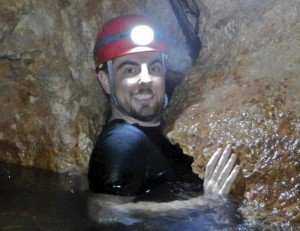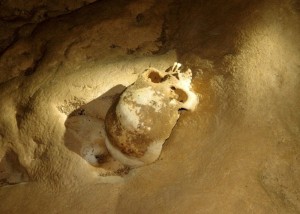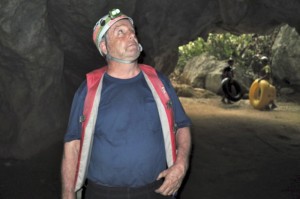Central America sits on limestone, beneath which are caverns aplenty, accessible via sinkholes and underground rivers. One of them is the ATM cave, which is shorthand for Actun Tunichil Muknal, or Cave of the Crystal Sepulcher. It’s got just about everything you could ask for, including ancient Mayan pottery, petrified skeletons and skulls, , narrow passageways, predatory spiders, bats—but no snakes. Indiana Jones would love it!
We were in water almost all the time. Sometimes we were ankle-deep, sometimes knee-deep, sometimes chest-deep, and sometimes we were in over our heads. We barked our shins and bonked our heads; we clambered up slippery slopes and slithered sideways through submerged fissures. Here is a picture of my son Alex squeezing himself through the narrowest of cracks.
It was taken during his first trip to the cave, when photography was still permitted. Today cameras are banned thanks to a clumsy tourist who in May of last year dropped his, inflicting blunt force trauma upon a thousand-year-old human skull. Here is a rare picture of said skull, taken by my son before the incident.
How did the skulls and bones get there? Current thinking is that the Mayans offered up human sacrifices in the cave and also smashed pots in order to appease gods and banish evil spirits. But who really knows? Could be the bones are the remains of pre-Columbian spelunkers who got lost whilst looking for rock formations that look like something other than rock formations.
The 19th Century cultural critic John Ruskin called it the pathetic fallacy, this tendency to ascribe animate characteristics to inanimate objects. Thus our guide Oscar was determined to point out each and every face-like profile along the way. And, honestly, what more is there for a cave guide to talk about, once he has explained the difference between a stalactite and a stalagmite, a column and a pillar?
The situation only grew more intense when we went cave tubing. This is a popular sport in Belize—floating through caverns on inner tubes—past formations of calcium carbonate, silica and manganese sculpted over eons by Mother Nature. But we only stopped whenever we came to a formation that looked familiar; for example, a petrified chandelier, a church bell, the Virgin Mary, George Washington, a Mayan warrior, an old man, and—finally—a jaguar.
“Do you see it, Mister Richard?” Carlos called out. “Do you see the jaguar?”
I did not see any jaguar. And even if I had, I wouldn’t have said anything. Or, as the poet Ogden Nash might have phrased it, “If you DO see a panther, don’t anther.”
Alas, Carlos wasn’t going to let me go until I saw the jaguar. So at last I lied and said, yes, I see it. Whereupon, the slowly moving caravan of tourists in inner tubes moved on.


